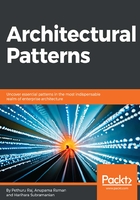
Domain-driven design (DDD) architecture
Domain-driven design is an object-oriented approach to designing software based on the business domain, its elements and behaviors, and the relationships between them. It aims to enable software systems that are a correct realization of the underlying business domain by defining a domain model expressed in the language of business domain experts. The domain model can be viewed as a framework from which solutions can then be readied and rationalized.
Architects have to have a good understanding of the business domain to model. The development team has too often worked with business domain experts to model the domain in a precise and perfect manner. In this, the team agrees to only use a single language that is focused on the business domain, by excluding any technical jargon. As the core of the software is the domain model, which is a direct projection of this shared language, it allows the team to quickly find gaps in the software by analyzing the language around it. The DDD process holds the goal not only of implementing the language being used, but also improving and refining the language of the domain. This, in turn, benefits the software being built.
DDD is good if we have a complex domain and we wish to improve communication and understanding within the development team. DDD can also be an ideal approach if we have large and complex enterprise data scenarios that are difficult to manage using the existing techniques.